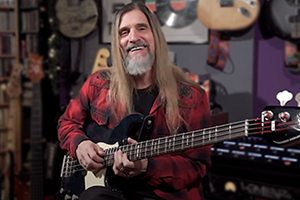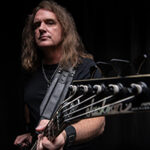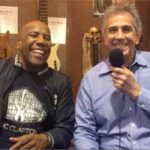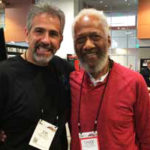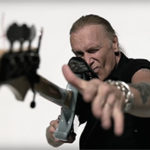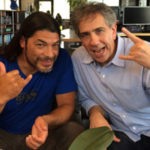Megadeth bassist reflects on rejoining the band and the state of contemporary rock
Exclusive interview with FBPO’s Jon Liebman
Nov. 1, 2021
James LoMenzo recently found himself invited back into Megadeth’s lineup, more than a decade after his last stint with the renowned metal band. A sought-after veteran of the music industry, LoMenzo made a name for himself playing bass with the glam metal band White Lion in the 1980s. Since that time, he’s made a career of playing with high-profile artists like Ozzy Osbourne, Zakk Wylde, David Lee Roth, Ace Frehley, and Slash. James has also been a member of Hail!, the all-star heavy metal tribute group. Prior to rejoining Megadeth, he served as a long-time member in John Fogerty’s band.
FBPO: I can’t believe your last interview with us was 10 years ago. You were talking about your Grandpa Angelo, Uncle Larry, playing the French horn…
JL: Unbelievable. Yeah, man. Wow. That’s 10 years gone by. Anything new happen between then and now?
FBPO: I was just about to ask you that very question. How does it feel to be back in Megadeth?
JL: It’s a wonderfully weird feeling. Last thing I expected this year, or any year, actually, was to get a call from Dave (Mustaine) to come in. But it was such a weird situation, and I guess they needed to get somebody onstage because this tour, this metal tour of the year, was set to go. I had been playing with John Fogerty, had a whole month of touring, lots of stuff going on. He was just going out, too, at that time, so it was kind of a delicate thing, because I’ve been with John for seven years. I hate to throw any monkey wrenches into that because he’s a wonderful human being, and they’re a great organization, and I hate to make things difficult. But at this point when I spoke with Dave, Megadeth really needed to get somebody onstage and get that metal tour done.
FBPO: It sounds like you had mixed feelings about it.
JL: I was excited at the prospect of it. Certainly, I had some trepidation about it because it had been over ten years. And I thought to myself, “Well, okay. How’s this going to fly?” So the first thing I did was what everybody else does in the world these days, I went on YouTube and I said, “Well, how did that used to look? What do I have to do? How do these songs go?” You know? And we had a video called Blood in the Water that we did in San Diego at the end of one of the tours. I think that’s when that particular version of Megadeth was probably at its most fit because we’d been touring for a couple of years. And I remember watching that and going, “Are you out of your F-ing mind?” You know? Like, “Did you just agree to do that?” But, nonetheless, I thought maybe I should see if I can pull off one more time. And so that was kind of an exciting premise to me.
FBPO: Did it come back to you pretty quickly?
JL: The learning curve for the music was a lot shorter this time because some of that stuff is still in some of my brain cells. But the problem is, as most musicians know, the more stuff you put in there, the more the older stuff just kind of squeaks out. It’s really funny because as I was going through the catalog and there were parts of the songs that were just gone, missing. I was kind of, “I don’t remember what to play at this part.” So thank goodness, with digital technology, I was able to stop the MP3, and find my way around. It actually didn’t take me too long to get the songs under my fingers. It was just building the endurance to play song after song after song, back to back.
FBPO: What kind of reception are you getting from the fans?
JL: That is actually the most amazing thing, that I get out there at the Megadeth thing and, my God, I mean, all the people who’ve taken the time to put posts on the web and Twitter and all that stuff, and even on a lot of the Megadeth pages and all that. My daughter keeps track of all this stuff, and she’s constantly sending me all this stuff. I said, “You’re not just sending me the positive stuff, are you?” And she goes, “No. This is what people are saying.” So I think maybe if I just step outside of this for a second, maybe because I have a lineage with the band already, maybe it’s more acceptable just have me kind of go back in, and be easily accepted.
FBPO: I guess that helps you focus on the music and not worry about anything else?
JL: Jon, every gig I get, I just try to do the best I can. And I think anybody who really loves playing their instrument and loves performing, that’s our goal. To get up there and make it as good as you can, especially at the live performance stage. I always found, in Megadeth, that to be the most important thing, because everybody knows the songs, most people can play the songs. But how do you get up there and perform the songs, and kind of stand and deliver them at that velocity, at that volume, at that intensity. And metal at its best, if you see great bands like Iron Maiden and Metallica, and all these bands, that’s what they do. They get on stage and it’s this just big ball of energy that starts from the first song and goes to the very last encore.
FBPO: Was the ten-year time gap your only trepidation about going back into Megadeth?
JL: Yeah, that was my only trepidation. I’ve had time to evaluate my career over the past 10 years, since last time we talked, and it’s an amorphous thing with anybody’s career. You kind of look, and you take stock, and you see all the plateaus, and all the valleys in your career. And you kind of go, “What did I do wrong? What did I do right?” It turns out you can’t really do anything wrong, you just keep going, right? And so when I thought back to Megadeth a few times, because I’ve done a few of these kind of interviews over time to speak about it, I honestly came out of Megadeth with a lot of really, really super positive things.
FBPO: How about the chemistry within the band?
JL: Dave Mustaine was just a wonderful guy to work for back in the day. And I know a lot of people who go, “Oh, are you out of your mind? We’ve heard stories.” But I can tell you that I’ve been in the belly of the beast. And yeah, he’s a general about his band, and the music, and Megadeth proper. But as far as his relationship with most band people, he’s really on point. He actually likes to keep it very close and very band-like, so I remember that being a real positive thing throughout. And also musically, performance-wise, that band has an amazing fan base. There’s so much music. I mean, I can’t even count how many albums now, but I know that Dave said the other day, he’s got over 600 songs written that have been recorded. That’s demonstrative. No, there was no trepidation about that. It really was about kind of revisiting it after 10 years and being a 60-year-old – an over 60-year-old dude now – as opposed to a 49- or 50-year-old dude like I was the last time.
FBPO: Switching gears, do you remember at the 2014 NAMM show, when I took you and Phil Chen aside to talk about the state of bass?
JL: Yeah. Basically, at that point, we might have had a beer or two too many, because we sounded like a couple of old guys trying to get people off of our lawn, off of our bass lawn!
FBPO: You said that the music back in the day, back in the ’70s, and even earlier, was made up of a bunch of styles that were fused together into a rock and roll forum. You cited R&B, fusion, jazz, and you said you no longer felt that amalgam of styles. Would you care to elaborate on that, now that it’s a little quieter, and we don’t have to shout because we’re not sitting in the middle of the NAMM show?
JL: I think that statement was somewhat erroneous at the moment. I like the amalgam of styles. I like the misinterpretation of one style becoming something slightly different, and something slightly new, and something slightly more exciting. This isn’t just through sampling, this is through actual live bass playing. There’s a lot of reach-back that is really refreshing to me in modern music that I really like to listen to now. So maybe I wasn’t listening correctly. Maybe it wasn’t really happening at that point, it wasn’t really turning me on, but I think we’re back.
FBPO: You also commented on the way production used to be done on records and that, on a lot of heavy metal records, the bass would kind of get squashed in the mix.
JL: Yes. There was a moment in the ’80s when it really wasn’t what it should be. What year did you start playing?
FBPO: I started on electric in 1975, and I started on upright in 1979.
JL: When you started playing, when you would listen to the radio, and the radio being maybe a transistor radio by your bed or a six by nine speaker in your dad’s car, like one, mono.
FBPO: Yeah.
JL: But there was Motown at that point, in ’75. There was still Led Zeppelin. There was still Ray Charles. All this stuff was still on the radio. And to me, you could definitely hear every bass note, on anything. And these were all songs that had come, maybe four or five years before we started playing bass. To me, the instrument itself was so preponderant. Obviously, the producers would push this instrument up front, to make those songs more interesting. The last time I went out and did a clinic tour, I actually spent two songs just demonstrating Chuck Rainey’s brilliance on Aretha Franklin’s music because I wanted people to see that it’s not just about sitting with the drums and playing notes. Sometimes it’s about creating countermelodies and actually making orchestrated parts, and how that all fits together. Back then, that was really in my mind’s eye. That stuff was really strong.
FBPO: Tell me about your bass gear.
JL: I’m still playing Ashdown amplification, since I started with David Lee Roth in, I think it was 2000. For this last Megadeth run, I had so little time to prepare for it that I just pulled the old rig out of mothballs, that I actually used on the last Megadeth tour that I was on. I still use my HyperDrive pedal. I don’t think they manufacture it anymore, but I always have that in front of everything because I could always fish out a really kind of interesting midrange and give it a little bit of a harmonic sheen, you know? And I like to do that with any guitar music. My bass guitars are all Yamahas, straight down the line. I just got this lovely 5-string, it’s a Nathan East model.
FBPO: Nathan East? Nathan’s done plenty of rock and roll, but when I think of Nathan, it’s the smooth jazz stuff that first comes to mind. Fourplay…
JL: And yeah, yeah, yeah. In all truth, I actually brought this out to “Megadeth World” because I love it so much. I played it, and it didn’t sound gnarly enough. It was too smooth. So I put it aside and started using one of their TRB 5-strings, which is their standard, which has a bit more of a more of a classic cut to it. And I’ve used their new models right off the rack. I mean, I can’t say enough great things about Yamaha’s lineup. I’ve got a couple of those Billy Sheehan basses. And what I do with those is put a couple of reverse P pickups by the bridge, which gives him a whole different-sounding texture than what Billy usually does, which is good by me because you still get that big punchy bass, but you get just kind of … Again, I just love weird harmonics. It’s a little something on top of the note.
FBPO: Have you been primarily a 5-string player lately?
JL: I used to play 5-string in White Lion, actually. Almost exclusively, from the first album to the third album, then I changed back to 4-strings.
FBPO: I would think in Megadeth you’d really need the 5-string.
JL: No, here’s the thing. Okay. This is really interesting. I came to this conclusion, and I used to vacillate back when I was in Megadeth the first time. You don’t need a 5-string in Megadeth, actually. There’s like four or five songs that utilize maybe one note in a particular scale at one particular time as a punctuation, and you wouldn’t miss it if it wasn’t there. However, the way I get around that is I have a sub-octave pedal that I have my bass tech punch in on those particular notes. And it works great because it still gives that kind of weight that you’d expect to hear there. And I get to play the 4-string. Now you’re saying, “Well, why play the 4-string when it’s for the 5-string things?” It’s lighter, it’s easier on my hands, I can move around more nimbly, I can play a little faster. It’s less to deal with. I don’t have to nurture that B string and keep it from rattling around. I could worry more about pointing to the person in the 20th row than holding onto the bass all the time. And for the famous “Hangar 18,” I actually learned to play this with drop D tuning. I had one of those drop D Hipshot D tuners on there. I’ve always used those, since the ’80s. And so for that particular song, I’ll actually start with the drop D tuning on that. Then, towards the end part, where I riff along with the guitar, I’ll just pick it, click it back into E and play along with them. And it all works great.
FBPO: I love the Hipshot stuff.
JL: I do too. And you know what? The thing about them is once you set those things up, I mean the D tuners, everybody’s like, “Oh no, it’ll never come back to pitch.” I never have any problem with these things at all. I mean, if you set them up just right and you follow the instructions and under tune them by 10%, and then bring it up to pitch, and then knock it around a few times, you can go all night with it. And I have.
FBPO: What kind of strings do you play?
JL: Still Rotosounds. Love the Rotosounds. Every time I get my new bass and they have their strings on it, I go, “All right, let’s see what this is all about.” After about 10 minutes, I’m like, “All right, let me see what this bass really sounds like now.” I’m just so used to that sound and that tension. It usually feels right to me.
FBPO: What advice do you have for someone who wants to learn to play the bass?
JL: If you really respond to the bass, you really should listen to great bass players. It’s not hard to do. You can go on YouTube, you can go on your favorite music streaming service, or even go into your CD library if you have that. Or for some of the older people, pull out your cassettes and just start listening to, pick any band, like the Rolling Stones, and just start focusing on what the bass guitar is doing and how it’s related to things. That’s one thing. The next thing is, after you get kind of better at doing that, stop listening to the bass player and start listening to the saxophone player, and start learning how to expand into melody and all these other great things. And the third thing I would say is just go slow. If it’s something that you really love, you have to nurture it. You want to make sure that you do it correctly, and you don’t tax your musculature, and that, mentally, when you start to learn how to read, you do it very slowly and very methodically so that you can put one concept into your mind after another. I think those are the main three things, really.
FBPO: So it all starts with listening?
JL: Most of it’s about listening. If you can listen and you can hear something, then your charge is to try and replicate it and try and go in that direction. And going in that direction, there’s no wrong answers. You can’t really hit a bad note. You can hit a new note, or you can actually reinvent what you heard, and you can actually misinterpret what you heard, and come up with something that’s still musical. But the main [thing] is just stay excited about it. And I think these kinds of concepts can keep you excited. Not get bogged down with, “Oh, I have to do this scale perfectly.” You will. In time, you will do every scale perfectly if that’s what your heart’s desire is. But to actually make music on the thing, you’ve got to look at the bigger picture. And the bigger picture is how does the bass relate in all these different genres of music with other musicians. And try and try and follow that, try and find that. And whatever you do, don’t watch anything by Jaco Pastorius for the first year because you’ll feel like you can’t play at all. But after the second year, once your fingers start moving, by all means, check this out. That’s my dream, that’s where I’m headed. See that big hill up there, Jon? That’s where I’m headed. That Jaco Pastorius hill.
See Jon’s blog, with key takeaways from this interview here.
